1. Dragana Dimitrijević: Assessment sheets for criteria-oriented and transparent evaluation: an example
Dragana Dimitrijević hails from Belgrade / Serbia. She has been working as HLT instructor for Serbian in the Canton of Zurich since 1999.
Together with my students, I have developed assessment sheets for different work areas (e. g. make a presentation, read something to the class, write an adventure text, etc.). The inspiration came to me based on the observation sheets from the teaching materials “language land”, which are used for grades 4–6 in many Swiss cantons. For me, it was important to develop the sheets together with the students, so that they collectively understand and support the assessment criteria.
I have implemented the sheets with the class, in order to develop the students‘ ability for observation and criticism, but I also use them for my own assessments.
The assessments can be easily differentiated according to proficiency level, where “I” stands for simple criteria, which can be fulfilled by lower-level students. The points for middle and upper-level competence are simply marked by “II” and “III”, respectively.
Example assessment sheet for presentations (can and should be expanded!)
| Name and class of the students; date: | |||||
| Theme of presentation: | |||||
| Criterion | insufficient | barely sufficient | good | very good | comments |
| Clear announcement, listeners know what the presentation is all about (I–III) | |||||
| Interesting introduction, raising curiosity about what follows (II–III) | |||||
| The content is understandable (I–III) | |||||
| Clear, transparent structure (III) | |||||
| Using pictures, music, objects, etc. for illustrative purposes (II–III) | |||||
| Conclusion with a summary of the most important points (III) | |||||
| Includes a worksheet, a quiz or a discussion of the presentation (II, III) | |||||
| Delivery of the presentation is clear and loud enough to be understood (I–III) | |||||
| The presentation is varied, not monotonous (II, III) | |||||
| Good eye contact with listeners (II, III) | |||||
A good, more strongly formative alternative to the four rubrics (from “insufficient” to “good”) would be only two rubrics, such as: “I liked the following especially in your presentation” (check at most four criteria) and “Pay more attention to this point next time” (check at most two criteria).
2. Aida Haziri: Differentiated commentaries as basis for purposeful continuation of work
Aida Haziri hails from Elbasan in Albania. She has been living in London for 16 years and has worked as teacher of Albanian HLT since 2004. – The student Amanda B. is attending the 4th class of the Albanian HLT.
Commentary to the below depicted translation exercise (The comments also apply to the other parts of the test, to which this exercise belonged):
You have done good work. In the future, pay attention to the following points:
- Use of quotation marks (“ “).
- Use of initial uppercase letters (names of countries, etc.).
- The beginning of a sentence is always capitalized!
- Use of colon: primarily when making a list or an enumeration.
- Don’t forget the dots on the ë; otherwise it will be read as an e!
- I am quite happy with your translation. But please pay attention to the exact word order [also in Albanian] in order to form a coherent sentence!
Oral discussion with the student concerning the following steps in her further work:
- On which three points of my above commentary would you like to work on?
- I propose the following exercises: … (e. g. write a short text on your own, in which quotation marks must be correctly set at least 5 times; write a short report where each sentence begins with a capital letter (paint it over in red); translate a short English text into Albanian with special attention to the syntax, etc.).
Corrected translation exercise:
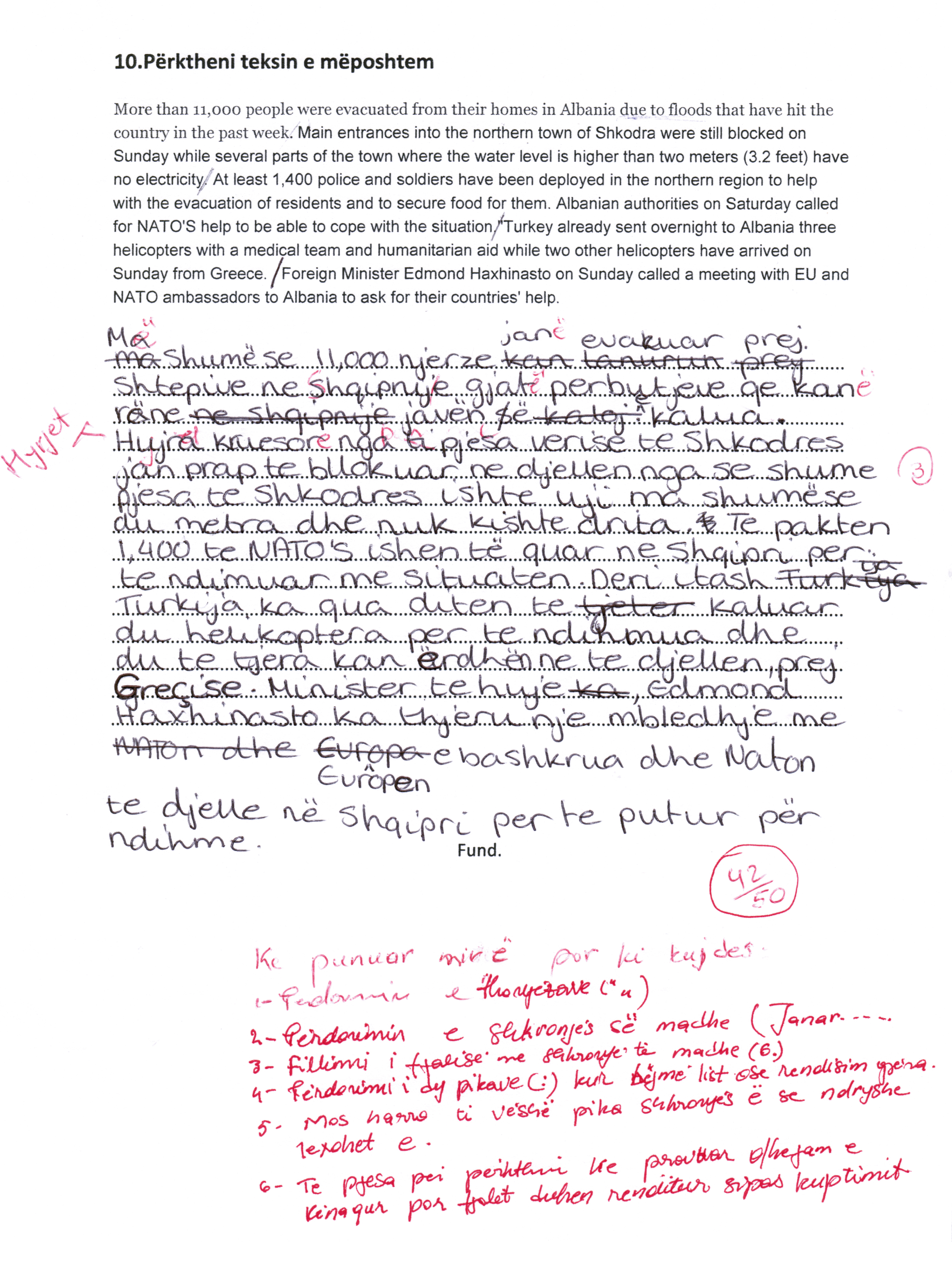
3. Birsen Yılmaz Sengül: Educationally-oriented evaluation of a grammar exercise for present tense conjugation
Birsen Yılmaz Sengül hails fromTurkey. She has been living in Nürnberg for three years and works there as an HLT instructor of Turkish. The student Açelya K. was born in Germany and attends the fifth class of high school.
Uplifting written commentary to the worksheet depicted below:
Comment to the exercise:
- In Turkish two vowels cannot follow each other (in contrast to German!).
- Pay attention to the difference between “i” and “ı” and between “s” and “z”!
Açelya, you are thinking in German, even though you are in Turkish class! But you are a very dedicated student. You will overcome these errors with a little more effort and not repeat them again next time!
Short support program in which the student learns how she can and should specifically address the most important problems.
- In a succession of vowels, pay attention to the “y”: Gidiyorum, not gidiorum. Write a short text in which this “problem” occurs at least three times!
- The Turkish language distinguishes between the two letters i and ı! Istanbul and ˙Istanbul are not the same. Find 10 such words in Turkish on your own in order to practice!
- In the 1st. form plural, the ending is always “z”, not “s”: Okuyoruz: Biz gazete okuyoruz, not okuyorus. Write 5 short sentences in which this form occurs!
- Pay attention: “s” in German is sometimes pronounced like “z” (voiced, example “Sonne”). In Turkish, it is always unvoiced (as with “es”). That’s how you often make mistakes.
Corrected worksheet:
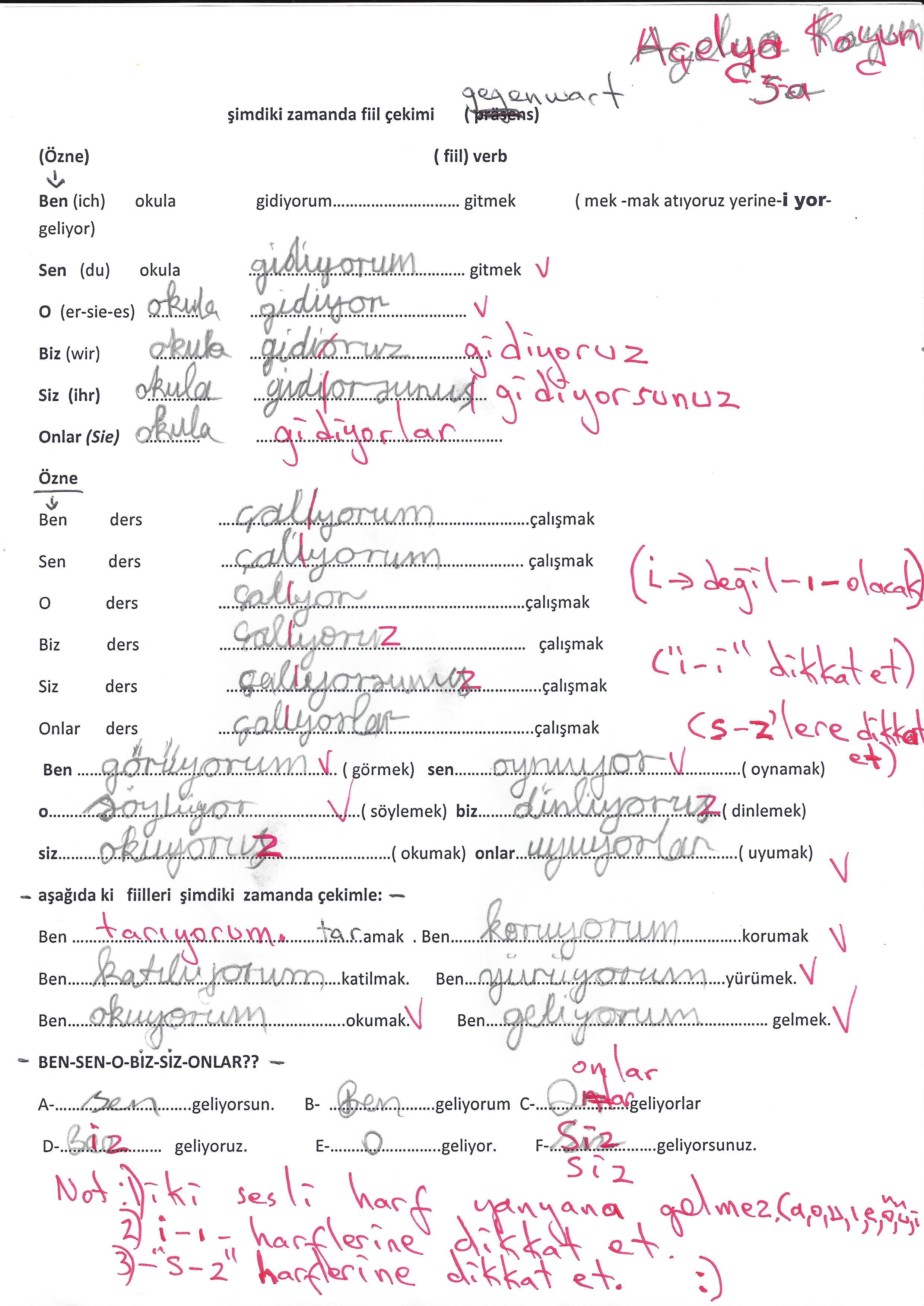
4. Spanish HLT instructors in London: assistance with writing of varied texts
At the St. Augustine‘s School on Oxford Road in London, the editor of this book noticed the following posters and “wall decorations”. The instructors of HLT Spanish classes there created them to provide their students with linguistic means to create diversified texts. Posters and instructional sheets of this kind are highly effective in serving the education- oriented work in the area of writing as well as with the criteria-oriented evaluation and assessment.
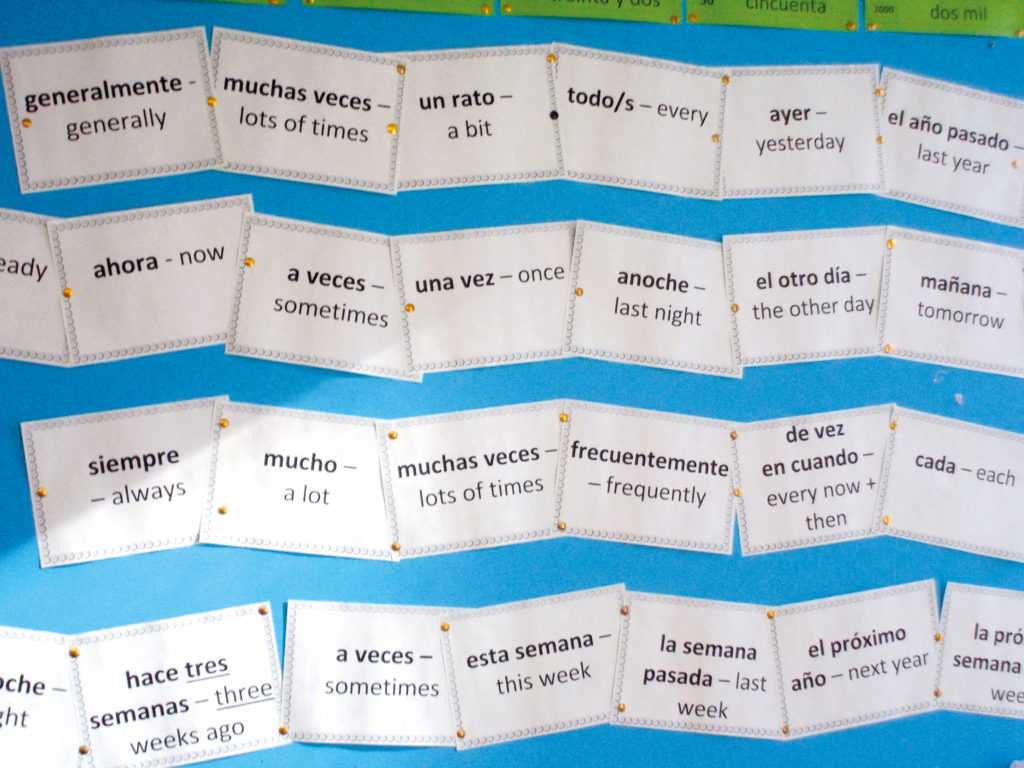
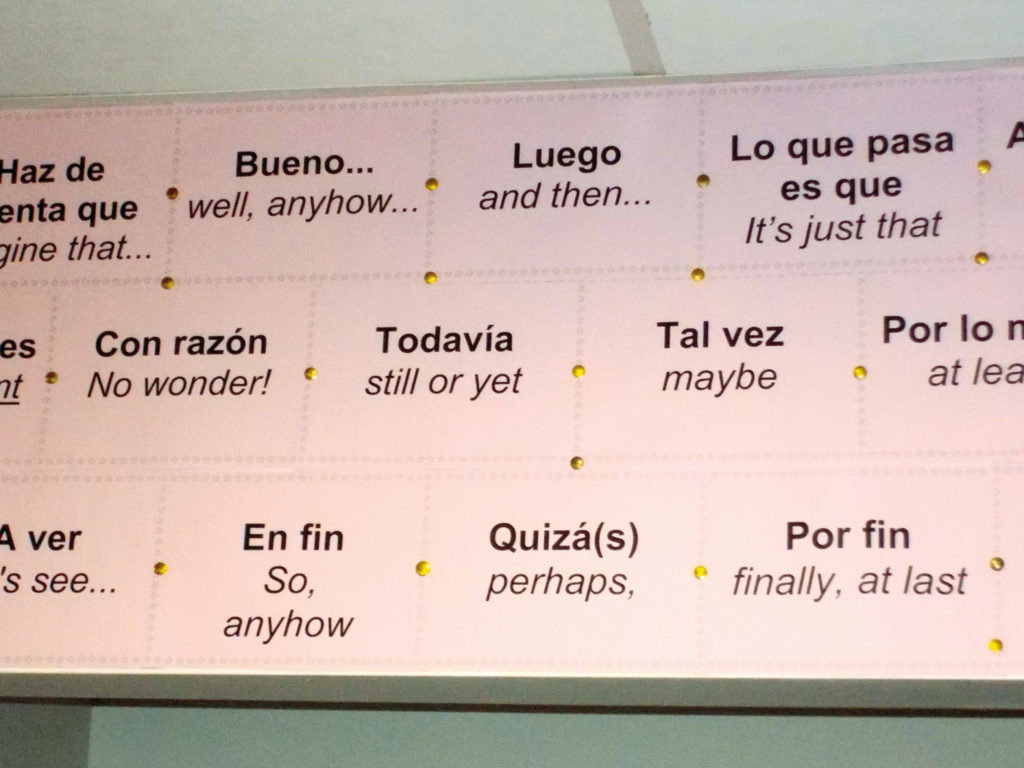
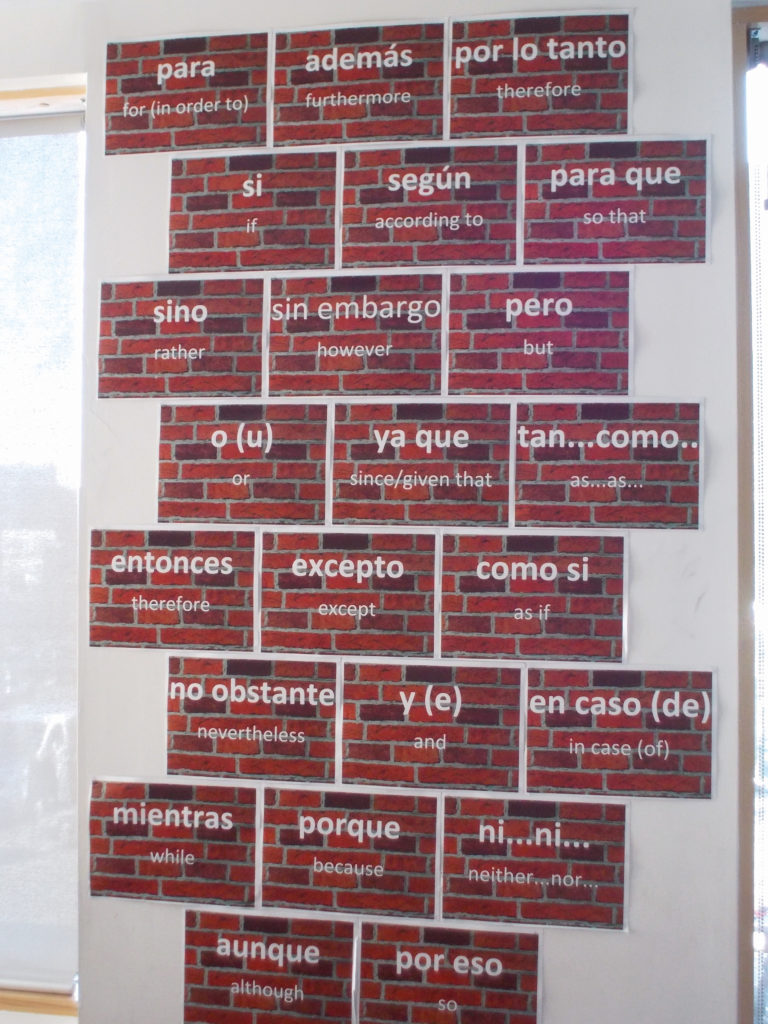
(With many thanks to the Spanish HLT instructors for the permission to reproduce!)






